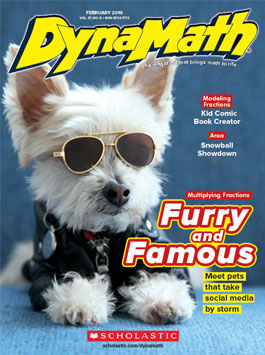I'm so excited to share what we have coming up for DynaMath this year! We've amped up our robust math education package with even more powerful leveling tools and flexible lesson ideas. Here are five new features you'll get:

What’s New In DynaMath
5 new ways we have lesson planning, differentiation, and math discourse covered
Tips for getting the most out of your subscription, both in print and online.
1. Grade-specific articles in every issue
Get targeted, real-world math for your grade level with our grade-specific features. (We order them in ascending level of difficulty in the magazine—third grade first, then fourth, then fifth. For example, to teach 3rd grade subtraction, we interviewed a scientist from Texas about her recent dinosaur research that says dinos sounded more like a cooing pigeon than a beast from the Jurassic Park films. It's a “roar” of a good story!
2. Revamped lesson plans with suggestions for leveling up and down
Check out our newly designed lessons plans! No matter what grade you teach, you can use any feature article in DynaMath by leveling your lesson up or down with our differentiation suggestions. Expertly crafted activities and skills sheets allow you to use any feature at multiple grade levels.
3. Handy standards correlations in the Teacher's Guide
Precise standards correlations for every article, skills sheet, and activity suggestion make planning and leveling a cinch. Plus, find standards for the whole issue at a glance on the back page of the Teacher’s Guide.
4. A Cool STEM Jobs article with a math hands-on activity
Each month, we’ll profile a real person working in STEM so your students can see the career applications of the skills they learn in the classroom. Our math hands-on activities support inquiry-based instruction and cover the elementary math used everyday in STEM fields.
In September, we covered a fearless skydiving engineer who is designing a superior wing suit.
5. “Math Talk” prompts encouraging mathematical discourse
As Jo Boaler wrote in her book, Mathematical Mindsets (a recommended read!), “explaining one’s reasoning is a mathematical practice, called reasoning, that is at the heart of the discipline.”
We couldn’t agree more, which is why we developed “Math Talk.” These prompts pose open-ended discussion questions about the math related to every article.
Last but not least, we have a newly designed website! Stay tuned for an upcoming post on its dazzling new features.
We’d love to talk! So, email us anytime.
Want more elementary math education tips and news? Check out Scholastic's archive.
Elizabeth Carney (@BethAnnCarney) is the executive editor of DynaMath and SuperScience, Scholastic’s STEM magazines for elementary school.
Recent Posts
-
July 7, 2021
SEL in the Math Classroom: Strategies for Resilience
-
January 30, 2019
Make the Most of DynaMath–With Google Classroom!
-
January 8, 2019
Easy Classroom Updates for 2020
-
December 3, 2019
4 Fun Ways to Use Math Around the Holidays
-
September 10, 2019
Fun Math Icebreaker Activity
Exciting ideas and fun teaching strategies for using DynaMath in 3rd, 4th, and 5th grade math classrooms


